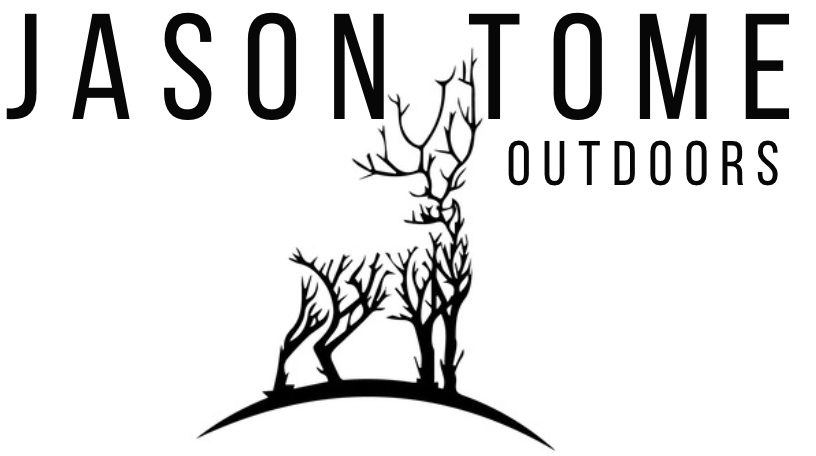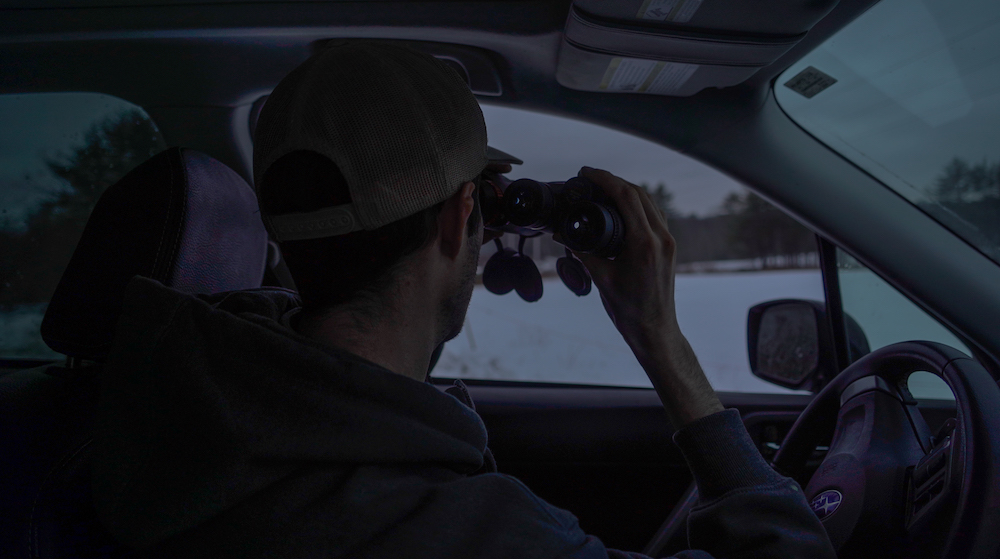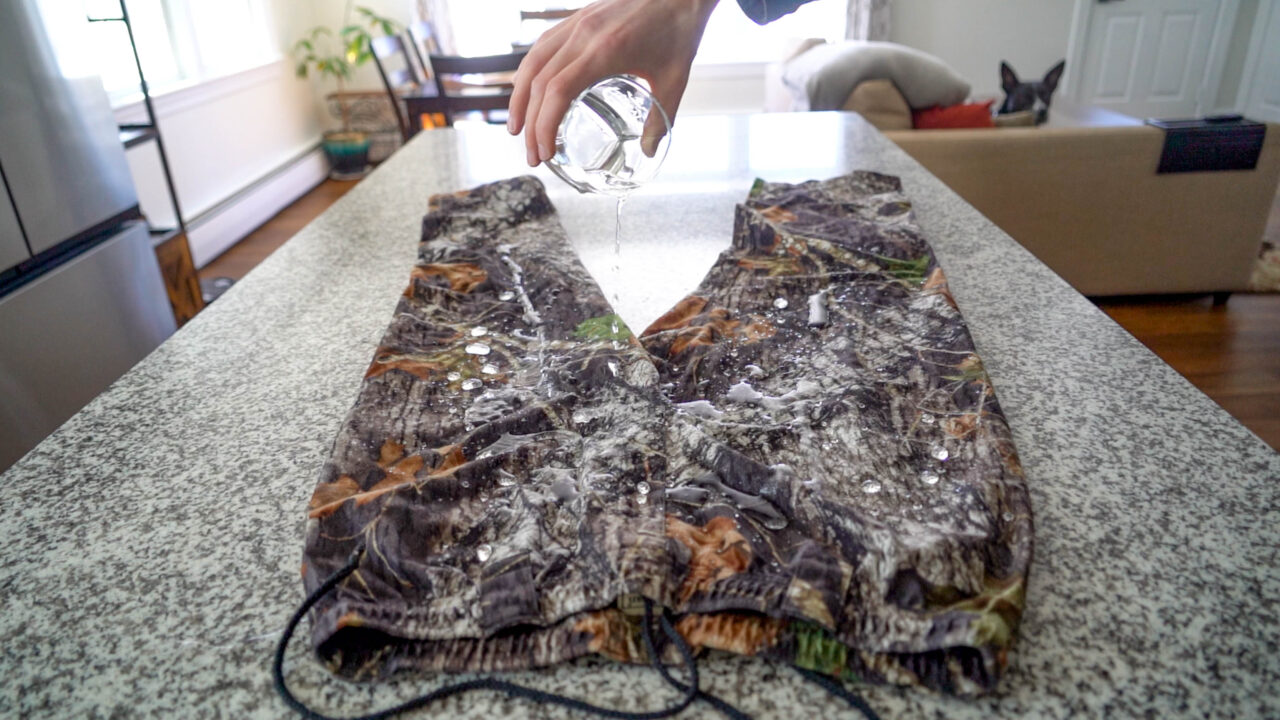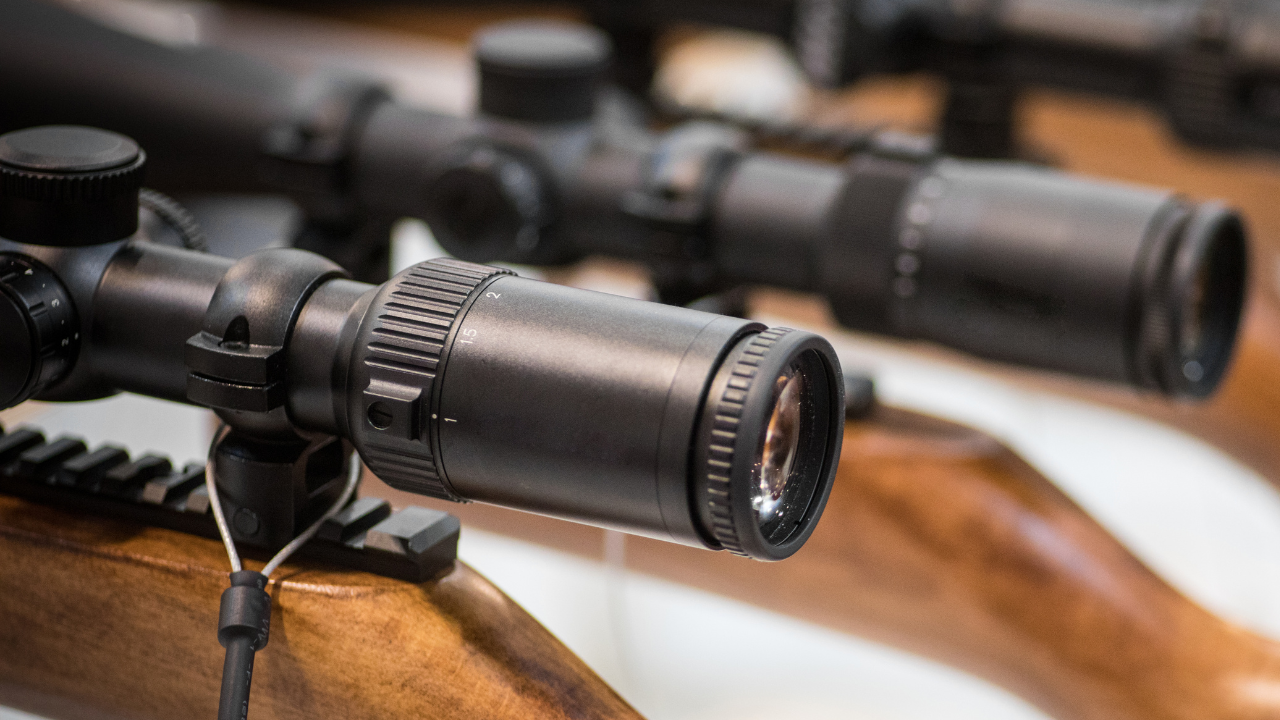To confidently choose the best hunting binoculars it is important to understand binocular terminology. This way you can make an informed decision based on what type of hunting you’ll be using the binoculars for. Once you understand the basic concepts of how binoculars and optics work, you can make the best decision for your particular hunting scenario.
This post will help you find the right binoculars for any scenario and explain WHY.
Table of Contents
How To Choose Hunting Binoculars
To get the most out of your hunting binoculars you will want to match binocular specs to what you plan to use them for. For example, weight, magnification, low-light capabilities…etc are all things to take into consideration when choosing binoculars. Each type of binocular has its pros and cons or ‘trade-offs’ and should be considered when buying binoculars. When these trade-offs are understood, you will be able to make the best purchase decision for your specific use, this way you’ll get the most value of your binoculars.
What Do The Numbers On Binoculars Mean? (8×42, 10×42, 10×50…etc)
The numbers on binoculars tell you the magnification and objective lens size. For example, on 8X42 binoculars, the magnification is 8X or 8 times the distance you can see with your naked eye. The 42 stands for how big the lenses are in diameter measured in millimeters of the end opposite of which you look through. In other words, the measurement of the light-gathering end of the binoculars. So you could also think of the numbers on binoculars as (8x)(42mm).

Binocular Magnification Explained
Which Binocular Magnification Is Best For Hunting?
Your goal should be to arrive at a perfect balance between binocular magnification and objective lens size that will best fit the type of hunting you will be doing.
- 8x — The standard magnification. Brings images close enough to see clearly but not so close that shaky hands are an issue.
- 10x — Those with steady hands or lots of experience tend to like the extra power, but shaky hands can be an issue for some.
- 12x — Most will need to brace their elbows to avoid a shaky image at this magnification; it is generally reserved for specialty uses, like hunting out west where a lot of scanning is done.
See Further!
The main pro for binocular lens magnification is that you can see further. For example, an 8×50 binocular can see 8 times further than your naked eye, a 10×50 can see 10 times further than the naked eye…etc.
Increased Binocular Magnification Considerations
There are some considerations to take into account before you buy a high-magnification binocular.
Perceived Shakiness of Hands
Higher binocular magnifications are harder to use off-hand because of increased hand jitters. Of course, your hands aren’t actually shakier because of having a higher magnification, it’s just that higher magnifications enhance small movements resulting in increased perceived shakiness.
A 12x magnification or larger really should have some sort of stabilization devices such as a monopod or tripod. The higher the magnification, the increased importance of better stabilization methods.
Field of View
Higher magnification binoculars also have a smaller field of view. With a higher-power lens, you may not see objects in your peripherals. While you’re busy looking into the deep depth of the landscape, there could be something 40 yards from you that you don’t notice. It will be harder to see with a higher power because your field of view is tighter.
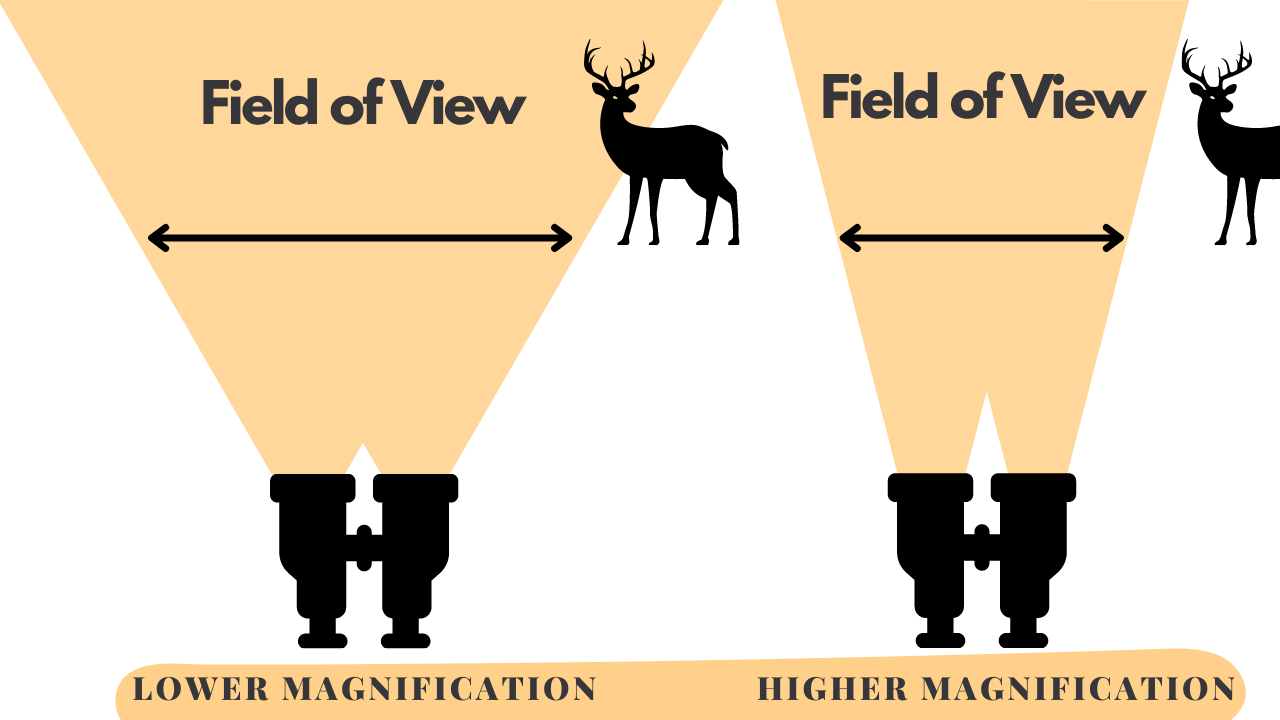
Binocular Magnification and Low-Light Performance
As you increase binocular magnification the lenses of the binoculars become more narrow. The narrowing of the lenses reduces the light-gathering capabilities of the binoculars. The lens narrowing allows you to see further, but reduces light gathering capabilities, and also is the reason your field of view shrinks. You can offset this low-light issue caused by higher-powered binoculars by choosing a larger objective lens size.
Binocular Objective Lens Size Explained
Binocular magnification is not the only thing that should be considered when buying hunting binoculars, objective lens size is just as important.
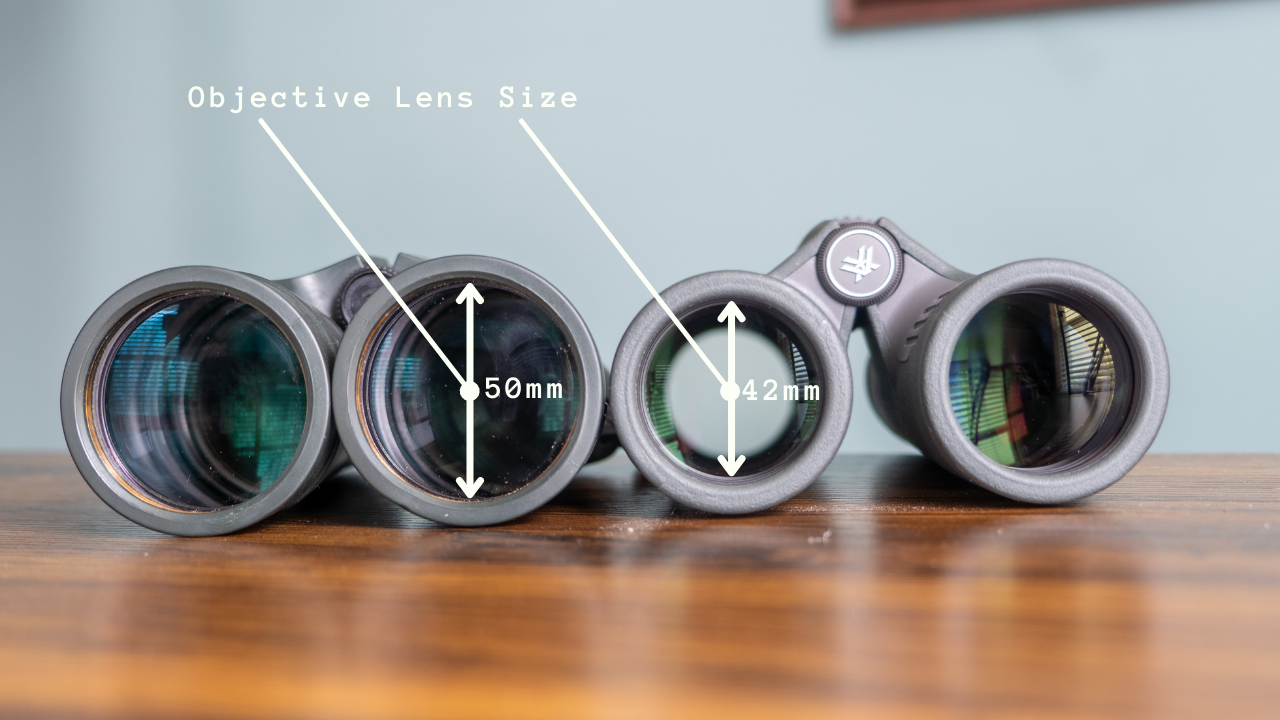
What Does Binocular Objective Lens Size Mean?
The objective lens is the end of the binoculars that you don’t look through. This is the side that actually gathers light. It is important to know the objective lens size because it is the low-light gathering potential of the binoculars, giving you a better image in low-light situations and often a crisper image overall.
On 8×42 binoculars, the 42 stands for the diameter of the lenses opposite of which you look through, measured in millimeters. In other words, it’s the measurement of the light-gathering end of the binoculars.
As your objective lens size increases, you’re able to draw more light into the lens. This allows for better low-light capabilities. However, there are also some considerations to make before you buy hunting binoculars with big lenses:
You have to be careful buying large-diameter lenses in conjunction with high magnification lenses. Glass is heavy. More glass = more free-hand shakiness.
For example, A 10×50 is better than a 10×42 in low-light situations (all things being equal) but the 10×50 will be a heavier binocular. This is good for those who need to see better in low-light but may need to consider stabilization methods like a tripod to keep them steady.
If you go with a 10×42 then you are sacrificing low-light capabilities because your lens size is smaller and can’t gather as much light but at least you can see further and it’s lighter and less bulky.
It’s all a trade-off, you can fine-tune your binoculars to the exact situations which will allow you to choose the best binoculars for you.
Will you be using them free-hand most of the time? Or will you be able to rest them on something or a tripod when hunting? These are some questions you should ask before buying binoculars.
How To Calculate Binocular Low-Light Performance
Exit Pupil Size
The exit pupil size is an easy calculation that will tell you how well a binocular will do in low-light situations. A higher result means better low-light performance capabilities of the binoculars.
Exit Pupil Size = (Objective Lens Size ÷ Magnification)
Binocular Magnification, Objective Lens Size, and Exit Pupil Size Relationship Chart
| Binocular Magnification (x) | Objective Lens Size (mm) | Exit Pupil Size (Low-Light Performance) | Type of Binocular |
| 7 | 50 | 7.14 | Full |
| 8 | 25 | 3.13 | Compact |
| 8 | 28 | 3.50 | Compact |
| 8 | 32 | 4.00 | Mid |
| 8 | 42 | 5.25 | Full |
| 8 | 50 | 6.25 | Full |
| 10 | 25 | 2.50 | Compact |
| 10 | 28 | 2.80 | Compact |
| 10 | 30 | 3.00 | Mid |
| 10 | 42 | 4.20 | Full |
| 10 | 50 | 5.00 | Full |
| 12 | 42 | 3.50 | Full |
| 12 | 50 | 4.17 | Full |
| 15 | 50 | 3.33 | Full |
| 15 | 56 | 3.73 | Full |
| 20 | 50 | 2.50 | Full |
| 20 | 70 | 3.50 | Full |
| 20 | 80 | 4.00 | Full |
So as you can see, all things being equal, 7×50 binoculars will have the best light gathering capabilities out of these examples by far. If lens magnification and size are all that matters, then why not buy cheap binoculars, right? Not so fast. Not all binoculars are created equal.
Types Of Binoculars & Objective Lens Size
There are three types of binoculars: compact, mid-sized, and full-sized. binoculars are categorized into these types by their objective lens size. For example:
- Objective Lens Size 30mm or less — These are referred to as compact lenses, these lenses sacrifice some light-gathering performance for their smaller size and lighter weight. They are good when weight is a factor.
- Objective Lens Size 42mm — These are mid-sized lenses, they are big enough to provide bright images even in low light, still quite small and portable, and offer good free-hand stability.
- Objective Lens Size 50+mm — These are large full-sized lenses that are heavy. They can be tricky to use freehand because of their weight. They’re generally reserved for low-light situations or to help offset the reduced light as a result of highly-magnified lenses.
What Makes Some Binoculars Better Than Others?
Understanding magnification, lens size, and how they relate to each other are the most important aspects to know when learning how to choose binoculars, but there are some finer details to know.
Quality Glass = Better Light Transmission
Not only does light have to get into the binoculars, but the light also needs to pass through the glass effectively. If a binocular has poor glass quality it will not be able to utilize the light efficiently. Thus, it will not perform as well as a binocular with glass that transfers light more efficiently.
Lens Coatings
You don’t want any reflection from your binoculars. Reflection from your lenses will deflect the light that you want entering your lenses. The best lenses will have coatings on them so that reflection is minimized to the furthest extent possible. This will allow as much light as possible to enter the binoculars so that you can see better in low-light.
Extra Low-Dispersion (ED) & High-Definition (HD) Glass
Extra low-dispersion glass (ED) also known as High-definition (HD) is, as the name implies, focuses the light color spectrum better. This reduces chromatic aberration. Chromatic aberration is the color-fringing (weird fuzzy coloring) that can occur at the edges of contrasting objects or landscapes. ED glass can also improve overall image clarity.
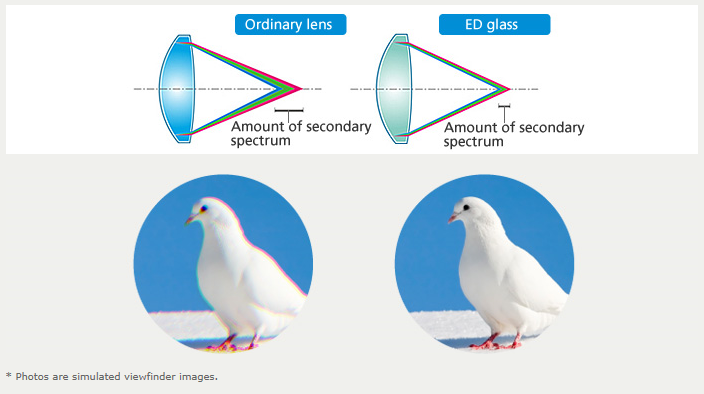
What Makes Binoculars Expensive?
Quality-made binocular glass makes a difference in how binoculars will perform. The best binocular glass isn’t created by automated manufacturing to the same extent, at least not yet. To achieve the best binocular glass, is made in-house with a lot of research and development. Because of this binoculars take longer to produce and require more employees, this is the reason some binoculars are so much more expensive than others.
Best Binoculars For The Money
Fortunately, high-quality binoculars are more affordable now that binocular manufacturing technology has improved. If you have an old pair that you’ve been using, it’s probably time to upgrade. You’ll notice a tremendous improvement. I tested 14 binoculars, at different price points ($250 to $2500), to determine the best binoculars for the money. I cover everything from entry-level to high-end binoculars and everything in between in the video below.
I tested 14 binoculars, at different price points ($250 to $2500), to determine the best hunting binoculars for the money. I cover everything from entry-level to high-end hunting binoculars and everything in between.
Are Expensive Binoculars Worth The Money?
There is a point of diminishing return when buying binoculars. You can obtain 80% of the quality by spending 10x less money. For example, the Athlon Midas binoculars cost +/- 250$, whereas the Swarovski EL’s cost +/- 2500$. So for 10x less money, you can still have at least 80% of what those expensive binoculars offer.
For me, if 250$ binoculars are even 70% comparable to 2500$ binoculars, that’s good enough for me. I put my binoculars to the test in all types of weather and through rough habitats and I don’t want to be worried about losing, dropping, scratching, or forgetting expensive binoculars.
Conclusion
I hope this article has helped you determine how to choose binoculars for your specific uses. That said, it’s a great idea to head to the store to get some of the binoculars in your hands and up to your eyes so you can get a better feel for how they will work for you.
I have also tested just about all of these binoculars in this review, hopefully, it has narrowed your search for the right binocular quicker. Out of the 14 binoculars I tested, I believe the Althon Midas binoculars are currently the best for the money. I currently use the Midas binoculars and would recommend them to anyone beginner or expert.
I found the Athlon Midas binoculars to be the best value binoculars because they offer, in my opinion, 80% of the value when compared to the most expensive binoculars that cost 5x-10x more money.
